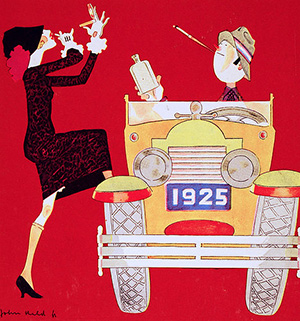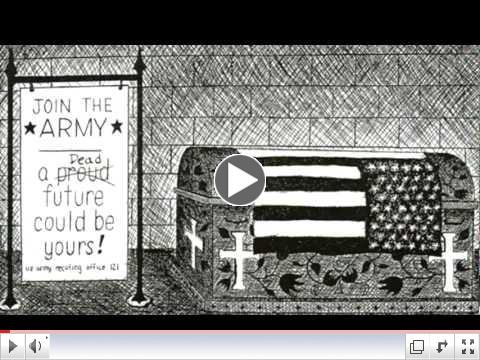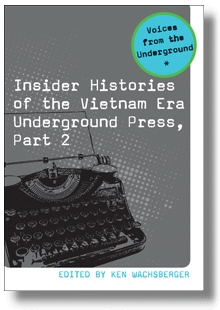Visit Our New 'Online University of the Left' and Be Amazed!

Check out the various departments, study guides and archives
|
Dialogue & Initiative 2012 The new annual edition of our journal of discussion and analysis is now out. More than 130 pages, it includes 13 articles related to the Occupy! movement, as well as seven others vital to study in this election year. Cost is $10 plus shipping. Or get one by becoming a new member or sustainer. Click the title to buy it directly.
|
Blog of the Week:  The 20 Best Free Movies on YouTube
|
Lost Writings of SDS..
Revolutionary Youth the the New Working Class: The Praxis Papers, the Port Authority Statement, the RYM Documents and other Lost Writings of SDS
Edited by Carl Davidson 
Changemaker, 273pp, $22.50
For the full contents, click the link and view 'Preview' under the cover graphic.
|
|
By Randy Shannon, CCDS

"Everyone has the right to work, to free of employment, to just and favorable conditions of work and to protection against unemployment."
- United Nations Universal Declaration of Human Rights, December 10, 1948
I. Introduction
The "Great Recession" that began in 2007 has caused the greatest percent of job losses since the Great Depression of 1929. This crisis is the end of an era of unrestrained 'neo-liberal' capitalism that became public policy during the Reagan administration. The crisis marks a new level of instability with the growth of a global financial elite that targeted US workers and our trade unions after World War II.
|
|
Order Our
Full Employment Booklets
 |
...In a new and updated 2nd Edition
Capitalism may well collapse under its own excesses, but what would one propose to replace it? Margaret Thatcher's mantra was TINA...There Is No Alternative. David Schweickart's vision of "Economic Democracy" proposes a serious alternative. Even more fundamentally, it opens the door to thinking about alternatives. His may or may not turn out to be the definitive "successor system," but he is a leader in breaking out of the box. |
|
Quick Links...
CCDS Discussion |
Sex and the Automobile in the Jazz Age

By Peter Ling in History Today: 'Brothels on wheels' thundered the moralists but Peter Ling argues the advent of mass motoring in the 1920s was only one of the changes in social and group relationships that made easier the pursuit of carnal desire.
|
 A Memoir of the 1960s by Paul KrehbielAutumn Leaf Press, $25.64 A Memoir of the 1960s by Paul KrehbielAutumn Leaf Press, $25.64 | | Shades of Justice Video: Bringing Down a President, Ending a War |
|
Carl Davidson's Latest Book:
New Paths to Socialism

Essays on Mondragon, Marx, Gramsci and the Green and Solidarity Economies |
Solidarity Economy:What It's All About

Edited by Jenna Allard, Carl Davidson and Julie Matthaei
Buy it here...
|

Voices from the Underground Press of the 1960s, Part 2- Foreword by Susan Brownmiller
- Preface by Ken Wachsberger
$37.50 + $6 shipping
|
|
|
|
An Invitation to CCDSers and Friends...
 Growing Madness in the Land...
We're the Committees of Correspondence for Democracy and Socialism...Do you have friends who should see this? Pass it on...Do you have a blog of your own? Others you love to read every day? Well, this is a place where you can share access to them with the rest of your comrades. Just pick your greatest hits for the week and send them to us at carld717@gmail.com!
Most of all, it's urgent that you defend voter rights, oppose austerity, make solidarity with the Occupy! movement and end the wars! We're doing more than ever, and have big plans. So pay your dues, make a donation and become a sustainer. Do it Now! Check the link at the bottom...
|
 | | Author: Sikh Temple Massacre the Outgrowth of Pervasive White Supremacism in U.S. Military |
A Democracy Now! Interview
AMY GOODMAN: We are talking about the killings of the Sikh Temple in Oak Creek, Wisconsin. Our guest is Pete Simi. He is a University of Nebraska at Omaha criminology professor, co-author with Robert Futrell of the book, "American Swastika: Inside the White Power Movement's Hidden Spaces of [Hate]," Joining us from Omaha, Nebraska. We're also joined by journalist Matt Kennard, author of the forthcoming book, "Irregular Army: How the U.S. Military Recruited neo-Nazis, Gang Members, and Criminals to Fight the War on Terror." Matt is joining us from Mexico City. Matt, you have been following white supremacists in the military for some time. Can you talk about the reaction to the killings in Wisconsin, and the more you hear about the profile of Wade Michael Page?
MATT KENNARD: Well, the interesting thing about Page is, you quoted that "Stars and Stripes" article which said he was completely open about his white supremacist and neo-Nazi inclinations in the 1990's. It's important to remember that during the 1990s, this was a period after the Burmeister trauma which you mentioned, and also the bombings in Oklahoma which were carried out by Timothy McVeigh, another veteran of the First Gulf War, who was decorated with a bronze star as well. So, military in the mid-1990s was embarrassed by the fact these first the active-duty veteran had committed murder; indiscriminate murder. The narrative is that they were cracking down at this point. Now, Page's example shows this was not really the case. What is [Unintelligible] is that during the War on Terror, even the thin regulations that did exist were completely jettisoned. I spent two or three years talking to veterans, extremist veterans, much like page, and far right leaders, who basically said that there was an open-door policy during the war on terror. You could enter with swastikas tattooed on you, with S.S. boats, with, basically, - basically the military couldn't slow down because the had two occupations to populate and not enough soldiers.
AMY GOODMAN: I want to ask you about the military's regulation of enlisted neo-Nazis and white supremacists. You write about how the Army Command Policy describes the rules for commanders to enforce. It says, "Participations in extremist organizations and activities by Army personnel is inconsistent with the responsibilities of military service." Matt Kennard, can you talk about the Army's regulations?
MATT KENNARD: Well, the Army's regulations, and in fact the military - the whole military, every branch - has been ambiguous on purpose, so that at times of chronic troop needs, like the War on Terror, they can basically allow these people to stay in. The regulations are basically reactive. The U.S. military, after a tragedy like in Oak Creek or the Burmeister case, they are embarrassed by the media reaction and the public who basically ask, why is our taxpayers paying to arm and train these right-wing extremists? So, the Army is on the back foot, and then they say, we have tightened the regulation. But, in reality, there is nothing proactive about it. Even the regulations that are in place, which obviously are thin, were basically completely jettisoned during the War on Terror. The quote you used about right-wing extremism being inconsistent with military service - I mean, it was completely consistent with military service during the War on Terror. In fact, I heard from extremist veterans themselves that their command would send them on the hardest missions because, obviously, neo-Nazis, and gang members as well - which was a big problem, which is worth mentioning as well - that they are seen more as war-like.
AMY GOODMAN: Talk more about this. White supremacists in places like Iraq and Afghanistan, and, unfortunately, as we have seen this past weekend, next to a Sikh temple.
MATT KENNARD: Well, that is a good point that hasn't been raised enough. What did it what did it mean for the occupied populations to have this army that was riven with white supremacists who saw the people they were occupying as subhuman, as well as violent gang members? Gangs is also a massive problem which we don't hear about as much about, because often the violence committed in the United States is inter-gang violence so it doesn't affect the public. There have been spates of murders between gangs involving veterans and active duty personnel. But, for the populations in Iraq and Afghanistan, we will never know what kind of atrocities were carried out Wisconsin-style. But, I'm sure they happened. I mean, there's a few clues as to what these soldiers were doing over there. One neo-Nazi veteran, called Kenneth Eastridge, is now serving a 10-year sentence for his part in a murder in Colorado Springs, and he was serving in Iraq with neo-Nazi S.S. boats tattooed on his arm....(Click title for more)
|
|

...While Supporting Oil and Gas Subsidies
By Tom Zeller, Jr.
Huffington Post
August 3, 2012 - Earlier this week, Mitt Romney's presidential campaign made clear that the Republican candidate would end a tax credit, currently set to expire at the end of this year, that the wind power industry considers crucial to its survival.
Speaking to the DeMoines Register, Shawn McCoy, a spokesman for Romney's Iowa operation, said that the candidate would "allow the wind credit to expire, end the stimulus boondoggles, and create a level playing field on which all sources of energy can compete on their merits."
This sounds reasonable, but there are two problems.
First, the Romney campaign has shown no commensurate desire to "level the playing field" by also eliminating lucrative and long-running tax breaks enjoyed by the fossil fuel industries. The campaign has, in fact, remained mostly silent on the issue when asked directly by reporters over the last many months, and repeated queries sent to the Romney campaign this week went unanswered.
Given the substantial support the oil and gas industry has shown for the Republican ticket, however, it's not difficult to imagine which way Romney would turn on this question. The Romney campaign was, after all, openly critical of the Obama administration's recent bid to eliminate some $4 billion in oil and gas tax loopholes.
Also worth noting: prepared testimony from billionaire Harold Hamm, chief executive of the Oklahoma-based oil company Continental Resources, submitted to the Senate Finance Committee in June. Hamm argued passionately that Congress should "maintain tax provisions critical to independent oil and gas producers."
Hamm is Romney's energy policy adviser.
Just how all of this squares with the Romney campaign's desire to "level the playing field" is difficult to discern. Even those conservative thinkers who celebrated the candidate's stance on the wind power tax break have argued that similar benefits should be eliminated across the board, for all energy producers.
"No form of energy production should get a leg-up via special tax treatment or direct subsidy from the government," Jim Lakely, a spokesman for the conservative Heartland Institute, said in an email. "A properly working and efficient free market operates on a level playing field for all. Government manipulation via subsidies distorts the market."
But there's another problem with this sudden interest in free markets and forcing all energy companies to compete without government assistance: It can't happen, because the market has already been wildly skewed by a very long and lucrative history of subsidies and tax breaks....(Click title for more)
|

The violence deepens and spreads. Yet unlike Egypt and Tunisia, the Syrian revolt has not had unanimous support from the Arab left. There is a split between those who sympathize with the protestors' demands and those who fear foreign interference, both political and military
By Nicolas Dot-Pouillard
Le Monde Diplomatique
August 4, 2012 - Last August the Lebanese leftwing nationalist daily, Al-Akhbar, went through its first crisis since its launch in the summer of 2006 (1). Managing editor Khaled Saghieh left the paper he had helped set up, because of its coverage of the Syrian crisis. Saghieh denounced the paper's lack of support for the popular uprising that began in March 2011. Al-Akhbar has never denied its political sympathies with Hizbullah, one of Bashar al-Assad's chief allies in the region, or hidden the fact that it prefers dialogue between the Damascus government and a section of the opposition to the fall of Assad's regime. The paper has given a voice to certain members of the Syrian opposition, including Salameh Kaileh, a Syrian-Palestinian Marxist intellectual who was arrested this April by the security services.
In June an article by Amal Saad-Ghorayeb (2) provoked dissension within the paper's English online version. The Lebanese commentator placed herself firmly behind the Damascus regime, and criticised supporters of a "third way" - those who denounce the regime while warning against western military intervention on the Libyan model. The same month another Al-Akhbar English journalist, Max Blumenthal, announced he was leaving in an article criticising "Assad apologists" within the editorial staff (3).
Al-Akhbar's crisis is symptomatic of the debate dividing the Arab left, ideologically and strategically. Some continue to support the Syrian regime in the name of the struggle against Israel and resistance to imperialism. Others stand staunchly with the opposition, in the name of revolution and the defence of democratic rights. Still others support a middle way between showing solidarity (from a distance) with the protestors' demands for freedom, and rejecting foreign interference: they advocate some kind of national reconciliation. The Syrian crisis is making the Arab left - whether strictly Communist, tending towards Marxist, leftwing nationalist, radical or moderate - seem in disarray.
There is little unequivocal support for the Assad clan, and few people are calling for the regime to carry on as it is; but unconditional supporters of the revolution do not seem to be in the majority either. Most of them are on the far left of the political spectrum, usually Trotskyist (the Socialist Forum in Lebanon, the Revolutionary Socialists in Egypt) or Maoist (the Democratic Way in Morocco). ...(Click title for more)
|
 By Jody Betzien By Jody Betzien
The Bullet
Red carpet and champagne marked the start of the first Red-Green Alliance (RGA) congress since the party tripled its mandate at a poll in September 2011. The 385 delegates representing the 8000 members packed a basketball stadium in the migrant and working-class Copenhagen suburb of Norrebro to grapple with the party's new increased influence on Danish politics. Party membership has more than doubled in the past two years, with the party welcoming into its ranks many ex-members of the Social Democratic and Socialist People's parties.
Danes voted in droves in last year's elections to punish the right-wing parties. The poll resulted in the Social Democrats heading a coalition government - and Denmark's first woman prime minister. But this took place on the back of the lowest vote for the Social Democrats since 1906.
There was also a collapse in support for the country's most right-wing parties, including the overtly racist Danish People's Party (DPP). The vote for left parties rose. The Social Liberals are the most conservative of the four left-of-centre parties supporting the government and the RGA the most radical. The RGA jumped from four to 12 seats in parliament, winning 6.7% of the vote. All RGA MPs get only a skilled worker's wage, donating the rest to the party.
The new government follows 10 years of conservatives in office. Among trade unionists and working-class communities that organized to oust the conservatives in a similar style to the Australian "Your Rights at Work" campaign, there are huge expectations. With the Social Democrats and their partners in the government rapidly reneging on election promises and tracking to the right, the RGA has unique opportunities and challenges ahead.
The minority Social Democrat government led by Helle Thorning-Schmidt relies on a coalition of left and centre parties to govern. The RGA supports the government against motions of "no confidence," but the party is not formally part of government and votes for legislation case by case. The votes of RGA MPs are crucial, however, to enable the government to pass key laws, including the budget....(Click title for more)
|

By VIJAY PRASHADCounterpunch Yesterday morning the orgies of the lone gunman took hold in Oak Creek, Wisconsin, a town in the dragnet of Milwaukee. He targeted a Gurdwara, the religious home of the local Sikh community. The gunman entered the Gurdwara, and as if in mimicry of the school shootings, stalked the worshippers in the halls of the 17,000 square foot "Sikh Temple of Wisconsin." Police engaged the gunman, who wounded at least one officer. The gunman killed at least seven Sikhs, wounding many more. He was then killed. A few hours after the shooting Ven Boba Ri, a committee member of the Gurdwara told the Milwaukee Journal-Sentinel, "It's pretty much a hate crime. It's not an insider." The local police smartly said that this is an act of domestic terrorism. The FBI concurred. This is the not the first act of violence against Sikhs in the United States. That story begins in the 19th century, when Sikhs migrated to the US, fleeing British colonialism for far-flung pastures. Many landed along the western coast of the United States, working alongside Japanese, Mexican and Filipino workers to make California into a fruit-producer and Oregon and Washington into major lumber producers. But they were not welcomed. Riots in Bellingham, Washington (1907) and Live Oak, California (1908) targeted the "rag heads," the turban-wearing Sikhs. The mob "stormed makeshift Indian residences, stoned Indian workers and successfully orchestrated the non-involvement of local police." The Bellingham Morning Reveille ran a drawing of a "Sikh" man with the caption, "This is the type of man driven from this city as the result of last night's demonstration by a mob of 500 men and boys." It was a mark of pride to have cleansed the city of the Sikhs. The Sikhs didn't take this lying down. A decade later, one Sikh man bragged, "I used to go to Maryville every Saturday. One day a ghora [white man] came out of a bar and motioned to me, saying, 'Come here, slave!' I said I was no slave man. He told me that his race ruled India and I hit him and got away fast." Anti-Sikh violence does not reside only in the early part of the 20th century. It returned a century later, when, after 9/11, Sikh men and women were targeted once more for their turban and head-scarf. Since Osama Bin Laden wore a turban, it was the turban that attracted the racist to the Sikhs. As I note in Uncle Swami, within the first week after 9/11, a disproportionately large number of the 645 bias attacks took place against Sikhs. The statement on the Oak Creek shootings that came from the activist group South Asian Americans Leading Together (SAALT) drew a straight line between the post-9/11 violence and this attack, "While the facts are still emerging, this event serves as a tragic reminder of violence in the form of hate crimes that Sikhs and many members of the South Asian community have endured since September 11th, 2001." Two quick reactions to the Oak Creek violence raised the hackles of some of the sharp organizers in the South Asian American community: * This was an act of senseless violence. "No," said Rinku Sen, publisher of Colorlines magazines. This is not "senseless," she noted, but "racist."...(Click title for more)
|
 | | Tom Waits - "Hell Broke Luce" |
By Rolling Stone
August 7, 2012 - What a build-up: Tom Waits has spent the past week dropping hints about an announcement he had planned for today, and the Web was thick with speculation: Could it be a tour? New music? A concert cruise? Nope. Turns out it was the release of a new video for "Hell Broke Luce," a scabrous, blackly comic anti-war song from last year's Bad As Me. The clip was the source of various surreal images posted on Waits' website last week, depicting the singer sporting an eyepatch and a scimitar, underwater flanked by boxy sharks (that turn out to be submarines) and poking an oversized spoon at a roaring fire.
Directed by Matt Mahurin, the video is as gritty as the song, as Waits pulls a small house through an arid, blasted landscape; over the ocean while surrounded by warring flotillas; and under water, trailed by boxy shark submarines.
Waits addressed the speculation over his clues in a statement: "As most of you guessed, it's a tour . . . a tour de force!" The singer said he and Kathleen Brennan, his wife and songwriting partner, envisioned the song as "an enlightened drill sergeant yelling the hard truths of war to a brand new batch of recruits. The video grew from the gnawing image of a soldier pulling his home, through a battlefield, at the end of a rope. I think you will agree, it's uplifting and fun."
|
 By Rod Such By Rod Such
The Electronic Intifada
July 14, 2012 - The recent decision by Morgan Stanley Chase International to remove Caterpillar from its socially responsible investment funds, specifically citing the corporation's "controversial" role in the occupied West Bank and Gaza (and the ensuing decision to follow suit by the teachers' pension investment firm, TIAA-CREF), testify to the growing strength of the Palestinian-led boycott, divestment, and sanctions movement (BDS).
The Case for Sanctions Against Israel is a newly-published collection of essays on the expanding BDS movement against Israel's policies of apartheid, repression, and ethnic cleansing. The book offers thorough background not only for the existing BDS activist community, but also for those just coming to the issue who may be unfamiliar with much of the history.
Among the 26 contributors, representing various backgrounds, are the Palestinian political activist Omar Barghouti, the Israeli historian Ilan Pappe, the British filmmaker Ken Loach, the Canadian journalist Naomi Klein and the veteran US civil rights activist Angela Davis.
The intelligence and absence of dogmatism reflected in these essays provide a basis for broad unity in the BDS movement, and a chronology of BDS achievements listed at the end of this volume, as well as the victories cited in several articles, also show that this movement is growing internationally. As with any critical examination, however, the contributors are also not reluctant to discuss setbacks along the way, as exemplified particularly in the essay by Stanford University historian Joel Beinin on the history of the BDS movement on US campuses.
Opposition to the Palestinian-led BDS campaign, organized and led by the Israeli government, centers on the claim that Israel bears no similarity to apartheid South Africa, the country that inspired the first global BDS movement. Several essays take on this objection, including those by South Africans Ronnie Kasrils and Ran Greenstein. Kasrils, an activist in his country's anti-apartheid struggle, concludes, "we South Africans who fought apartheid have been unanimous in finding Israel's methods of repression and collective punishment far, far worse than anything we saw during our long and difficult liberation struggle."
Artful dodges by BDS opponents
Other objections to BDS might be more accurately described as artful dodges as they pick away at the movement without tackling its arguments head-on. Artful dodge number one says the campaign should focus solely on boycotting products produced in Israel's illegal settlements in the occupied West Bank - implying that a comprehensive boycott of the Israeli state is "anti-Semitic." Leading BDS organizer Omar Barghouti notes that the Palestinian BDS National Committee is not opposed to targeted boycotts.
But those who sincerely wish for the BDS campaign to bring sufficient pressure on the Israeli government for the campaign to succeed should note the essay in this collection by the Israelis Dalit Baum and Merav Amir, the coordinators of Who Profits?, a project of the Coalition of Women For Peace that has mapped out how corporations enable Israel's crimes against humanity. They argue that Israel's economy is so intertwined with the occupation that it is impossible to separate settlement enterprises from Israel as a whole. "The Green Line border has all but disappeared from the corporate activity map," they write. "Even if we consider only the Israeli settlements, and then again focus only on settlement construction, we discover that the major players in the Israeli economy are deeply complicit with the occupation."
Artful dodge number two focuses on the academic and cultural component of BDS with the argument that it infringes on academic freedom and interferes with the cultural dialogue needed for peace and reconciliation between Jewish Israelis and Palestinians. Several essays take on this objection....(Click title for more)
|
|
Become a CCDS member today!
 The
time is long past for 'Lone Rangers'. Being a socialist by your self is
no fun and doesn't help much. Join CCDS today--$36 regular, $48
household and $18 youth. The
time is long past for 'Lone Rangers'. Being a socialist by your self is
no fun and doesn't help much. Join CCDS today--$36 regular, $48
household and $18 youth.
Better yet, beome a sustainer at $20 per month,
and we'll send you a copy of Jack O'Dell's new book, 'Climbing Jacobs
Ladder,' drawing on the lessons of the movement in the South in the
1950s and 1960s.
Solidarity, Carl Davidson, CCDS |
|
|